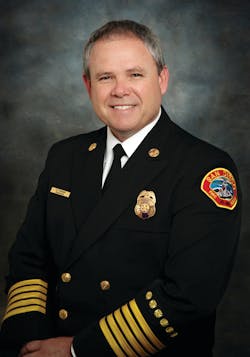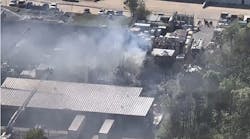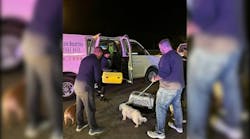Firehouse: Why is it that the citizens of San Diego never seem to have backed legislation, bond issues or votes for more funding for fire protection in either the city or county?
Mainar: As is the case in many communities across our nation, San Diegans have historically been fiscally conservative in their approach to funding public services. The deep recession we have experienced over the past decade along with increased criticism of public employee compensation packages and distrust of public officials has made the electorate more reluctant than ever to increase their tax rates to provide greater levels of service. While this is the case, in the aftermath of the 2007 wildfire, a ballot measure seeking a parcel assessment to provide additional firefighting resources was placed on the ballot. Although the measure passed in the city, it failed to win approval in the county. As a result, the measure was defeated. A more recent ballot measure to increase funding just in the City of San Diego was soundly rejected by the voters.
Firehouse: There are 47 fire stations protecting a city of 331 square miles with about one-quarter of the city in brush areas. Recent accreditation studies call for 19 new fire stations. In today’s economy, is that feasible?
Mainar: We recently engaged Citygate Associates to conduct a Standards of Response Coverage Deployment Study. Their analysis found that due to San Diego’s unique topography of winding roads divided by canyons, it was not fiscally prudent to build the large number of fire stations it would take to be fully compliant with NFPA 1710. This resulted in adoption of a modified NFPA 1710 first-due engine response time goal of 7:30 from time of call receipt to arrival. Given this more appropriate response time goal, Citygate determined that the city’s current deployment of 47 fire stations left 19 gaps in coverage. Ten of these gaps are large enough to justify the building of a fire station and nine could be covered by an alternate response concept we have named Fast Response Squads (two-person mini-pumpers). Addressing all of the capital needs identified in the Citygate Report would require approximately $98 million and the annual operating costs would be approximately $41 million. The recommendations and fiscal priorities have since been translated to a five-year implementation plan that has been adopted by our City Council. While it is a significant step to have a plan in place, identifying the needed funding will be the key to implementing the plan.
Firehouse: The department is 200 firefighters below levels a few years ago. Will the department hire new firefighters?
Mainar: Our firefighter staffing levels are down about 100 from previous years due to a management decision to backfill some vacancies with overtime rather than to hire firefighters to replace those who have retired or moved to other agencies. This was done as a cost-savings measure since it is less costly to pay overtime than to hire a fully benefitted employee. While we have not conducted a fire recruit academy in two years, we will be running one in July of this year. A one-week application period with little advertising yielded approximately 4,800 applicants for the 30-60 anticipated openings over the next two years.
Firehouse: A ballot initiative is coming in June to replace the defined benefit (pension) plan with a 401(k)-type program. How would that affect the department?
Mainar: A Comprehensive Pension Reform (CPR) initiative has been placed on the ballot and is supported by our mayor and some members of our City Council. If approved by the voters, this would end the defined benefit retirement plan for all new city employees except police officers and replace it with a 401(a) plan, which is similar to the better-known 401(k). While the impact on hiring of firefighters is not yet known, I predict we will always see a large number of applicants for our openings, but unless other large agencies in California follow suit with pension reform, we will see our new firefighters move to agencies with better retirement plans once they have bolstered their resume with service in San Diego. If this occurs, our training costs would increase and we would be challenged to maintain the high level of service we currently provide with more experienced personnel.
Firehouse: In the past, the department had to brown out numerous units each day. How did the department find the funding to keep all units open?
Mainar: For a period of 17 months, we browned out up to eight of our 47 fire engines each day to save $11.5 million in overtime expense. Because this negatively impacted response times and caused concern within the communities that felt the greatest impacts, our mayor and City Council made restoration of the brown outs a priority for new revenues in the city’s budget. Thankfully, this practice ended on July 1, 2011, when our City Council allocated an additional $11.5 million in our budget to fully restore these units.
Firehouse: The department has operated its training at the Naval Training Center (NTC), which the Navy let the fire department use. This center may be used for other city business. Are there any plans to relocate the training academy or to have satellite locations?
Mainar: If our Regional Public Safety Training Institute at NTC is relocated to accommodate a higher need of the city, we will need to identify replacement facilities for both fire and police training activities. Should this occur, I see it as an opportunity for us to partner with other area fire agencies to develop three or four joint-use training facilities throughout our region. This would reduce the amount of time our units are out of service traveling to and from a centrally located training facility like NTC. This would not only make training delivery more efficient and less impactful to response coverage, but should also yield greater opportunities for cross-agency training and savings through elimination of duplicate training facilities.
Firehouse: There has been a tremendous amount of building downtown. Can the department keep up with all the high-rises being built?
Mainar: There are now 205 high-rises in our city. Many are in our downtown area where no new fire stations have been built since 1971. Two new fire stations are planned to address the tremendous growth we’ve seen in our core and were slated to be funded by redevelopment activity. Unfortunately, the building of these new stations is now threatened by the governor’s elimination of redevelopment agencies and their funding. It remains to be seen what the impact of this change would be and how the stations would be funded if not via redevelopment dollars.
Firehouse: With a county fire department in its infancy, how will the city department work with county units and continue to work with other nearby departments?
Mainar: There are over 50 fire agencies in San Diego County. The county’s efforts to establish a fire department is really a consolidation of several of the smaller departments under one leadership and funding umbrella. This will ultimately reduce the number of independent agencies and provide cost efficiencies. While automatic and mutual aid agreements are well established in our region, area fire chiefs have been hard at work improving coordination among all of our response agencies.
One significant step forward was the connecting, in real time, of all of our dispatch centers. This has allowed us to drop our jurisdictional boundaries and dispatch one another’s resources to ensure the closest unit is always selected for the response. We have also working through the challenges of developing common operational procedures and using technology to ensure common operating pictures are provided to all responder agencies. In the end, these efforts benefit the community and our firefighters.






